This article [Copying Pictures, Evidencing Evolution] was originally published in The Public Domain Review [http://publicdomainreview.org/2016/05/18/copying-pictures-evidencing-evolution/] under a Creative Commons Attribution-ShareAlike 3.0. If you wish to reuse it please see: http://publicdomainreview.org/legal/

✅ AI Essay Writer ✅ AI Detector ✅ Plagchecker ✅ Paraphraser
✅ Summarizer ✅ Citation Generator
By Nick Hopwood
New images are flooding the world, and the sciences contribute more than their fair share. But open a textbook, turn on the TV, or visit a webpage and look at the pictures. There among the recent entrants from laboratories, clinics, and field sites, a few golden oldies jostle for attention. While most images fade away fast, a minority represent knowledge for long periods—even in science, where we might have expected constant updating. The checkered history of one extraordinary image family can illuminate these afterlives.
Striking comparisons of vertebrate embryos debuted in the books by the anticlerical German zoologist Ernst Haeckel that took a Darwinist system to the reading public in the 1860s and 1870s. The Natürliche Schöpfungsgeschichte (Natural history of creation) went through eleven editions between 1868 and World War I and was translated into a dozen languages; it was “perhaps the chief source of the world’s knowledge of Darwinism.” The more embryological Anthropogenie managed six editions between 1874 and 1910 and was twice translated into English as The Evolution of Man. With fossils in short supply, comparative embryology offered compelling evidence of common descent. Haeckel arranged this in vivid visuals for the first time.
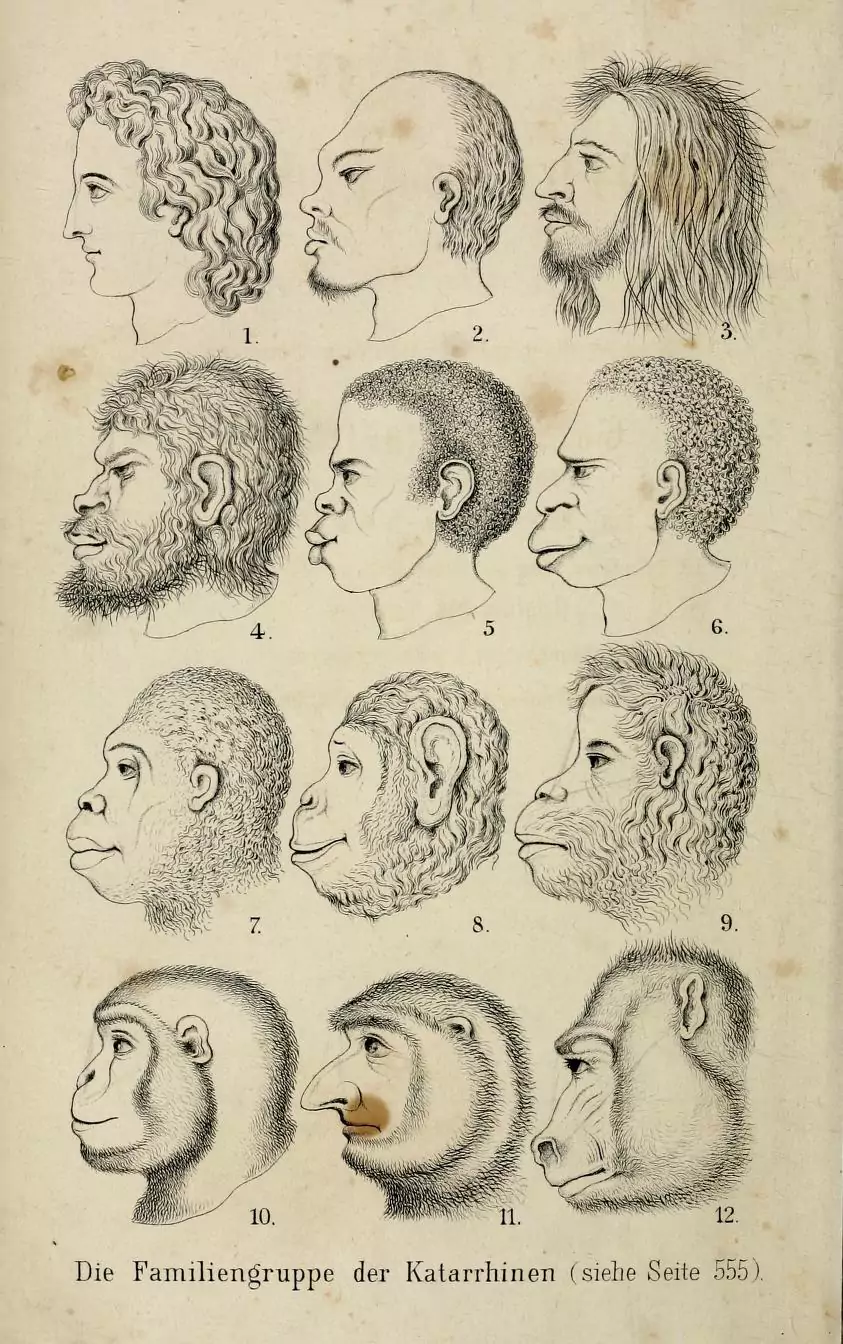 Natürliche Schöpfungsgeschichte (1868), Haeckel’s gospel of evolution.” width=”843″ height=”1344″ class=”size-full wp-image-19599″ /> The notorious frontispiece comparing heads of human races and apes in the Natürliche Schöpfungsgeschichte (1868), Haeckel’s gospel of evolution.
Natürliche Schöpfungsgeschichte (1868), Haeckel’s gospel of evolution.” width=”843″ height=”1344″ class=”size-full wp-image-19599″ /> The notorious frontispiece comparing heads of human races and apes in the Natürliche Schöpfungsgeschichte (1868), Haeckel’s gospel of evolution.Haeckel’s embryos come in grids. The “columns” correspond to vertebrate species, in the lithograph from the Anthropogenie members of the four lower classes: fish, salamander, turtle, and chick, and four mammals: pig, cow, rabbit, and human. The rows stand for stages, here “early,” “fairly early,” and “late.” We see the embryos begin very similar and diverge towards their adult forms. Look harder and there is also evidence for Haeckel’s dictum “ontogeny recapitulates phylogeny”: we climb our evolutionary tree in the womb. For example, the top row corresponds to an ancestral stage equivalent to the jawless fish. But differentiation from a near-identical origin is the more obvious point, and provocative enough, especially when surrounded by liberal rhetoric and swipes at religion. Let the “church militant” damn “the naked facts of human germ history” as “diabolical inventions of materialism, Haeckel thundered, “embryology is the heavy artillery in the struggle for truth.
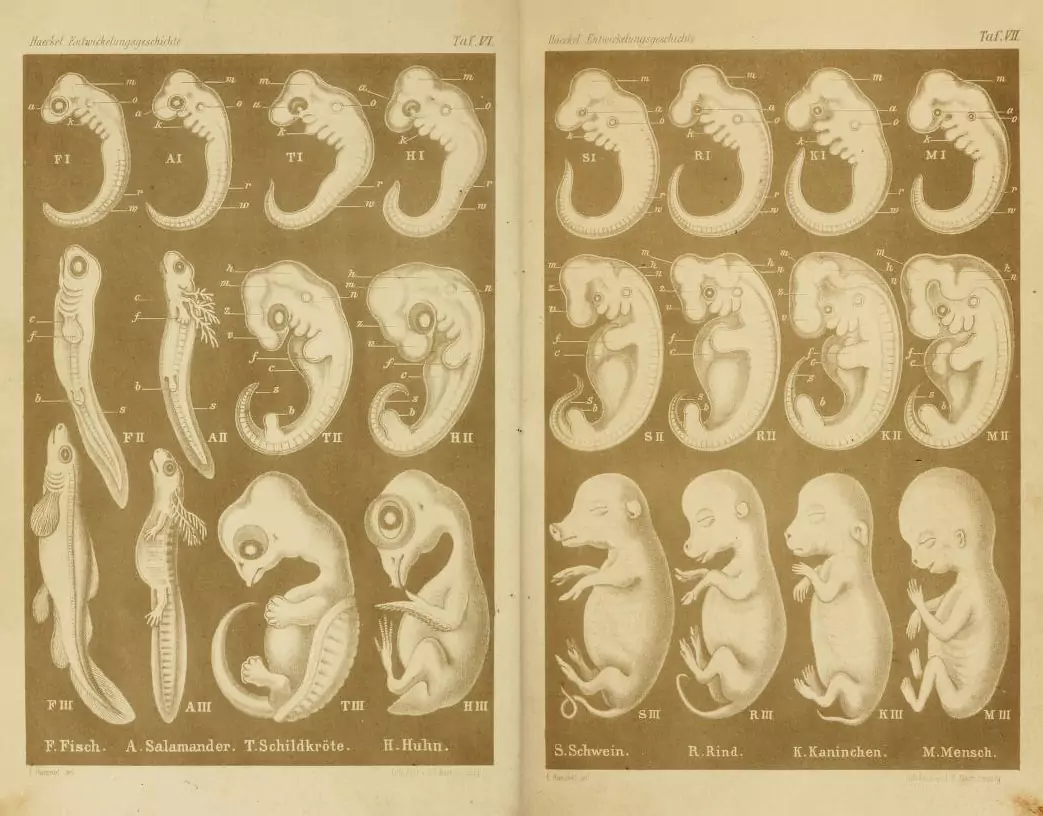 Anthropogenie (1877).” width=”1043″ height=”816″ class=”size-full wp-image-19600″ /> Comparison of vertebrate embryos at three different stages of development from the third edition of Haeckel’s Anthropogenie (1877).
Anthropogenie (1877).” width=”1043″ height=”816″ class=”size-full wp-image-19600″ /> Comparison of vertebrate embryos at three different stages of development from the third edition of Haeckel’s Anthropogenie (1877).The Schöpfungsgeschichte had not been out a year when a researcher sympathetic to evolutionism, but hostile to Haeckel’s approach, accused him of various pictorial misdemeanours. Infamously, Haeckel had had single woodblocks printed three times to represent the embryos of a mammal, a bird, and a reptile. He corrected this sharp practice in the second edition and eventually admitted his “extremely rash foolishness.” More debatable are the plates, on which he was charged with skewing the evidence by drawing the embryos more similar than they really are. These allegations came to a head in the mid-1870s, when Haeckel’s Anthropogenie put embryology in the eye of a storm over Darwinism, not to mention major confrontations between the state and the Catholic Church, and between evolutionists and physiologists in biology. The “German Darwin” countered that his figures were schematics, appropriate simplifications that legitimately expressed his view; would his critics have him draw without thinking? With the theory of evolution underpinning ideologies of progress, enough people took his side that the plates could stay in his books, but the fraud allegations never went away. In 1908–10, they flared up in a larger, nastier battle that made front-page news in Germany and was reported internationally, including in the United States, then taking over as the powerhouse of science.
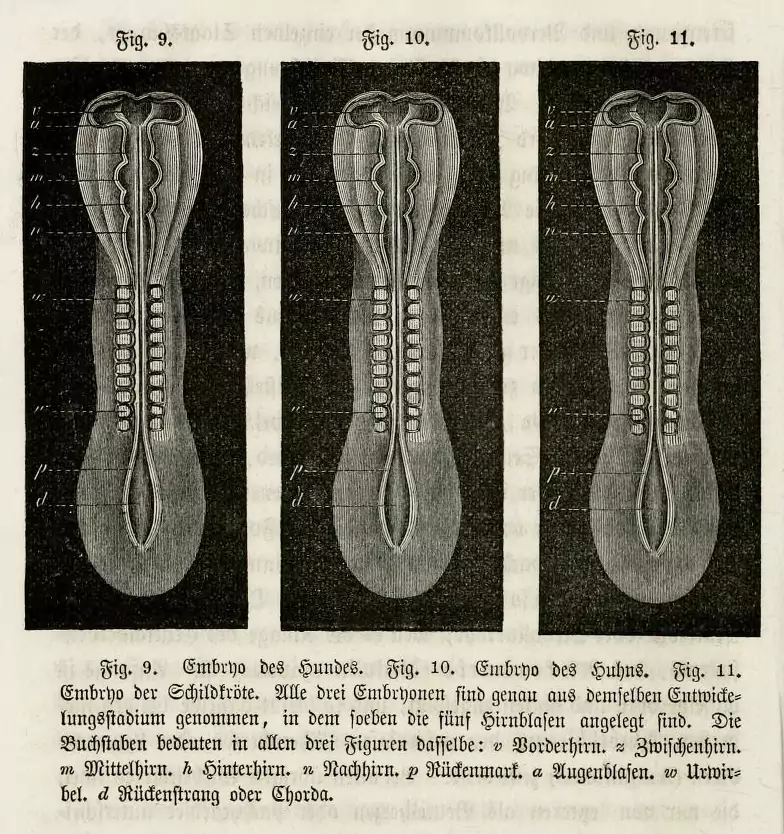 Natürliche Schöpfungsgeschichte (1868).” width=”784″ height=”834″ class=”size-full wp-image-19601″ /> Wood engravings of dog, chick, and turtle embryos printed from the same block in Haeckel’s Natürliche Schöpfungsgeschichte (1868).
Natürliche Schöpfungsgeschichte (1868).” width=”784″ height=”834″ class=”size-full wp-image-19601″ /> Wood engravings of dog, chick, and turtle embryos printed from the same block in Haeckel’s Natürliche Schöpfungsgeschichte (1868).Haeckel’s diagrams still became standard textbook illustrations of comparative evolutionary embryology in twentieth-century American high school and college textbooks. Until another intense controversy, that is. By the mid-1900s, embryologists had largely abandoned Haeckel’s questions, but from the 1980s some became interested in evolution again, and in 1997 one accused him of fraud—in ignorance of the long history of forgery charges. Many biologists now rejected the pictures, and the neo-creationist advocates of intelligent design forced some publishers to take them out. Putting “Haeckel’s embryos” into google takes you to websites like Answers in Genesis and Darwinism.refuted.com. But Darwinism should not be at stake: the molecular homologies discovered in the last few decades confirm the fact of evolution more persuasively than Haeckel ever could. Where his embryos do excel, however, is in providing food for thought about how images succeed and fail.
 Advanced Biology (1929) for secondary schools. ” width=”1192″ height=”1746″ class=”size-full wp-image-19602″ /> Embryo grid in Frank Wheat and Elizabeth Fitzpatrick’s Advanced Biology (1929) for secondary schools.
Advanced Biology (1929) for secondary schools. ” width=”1192″ height=”1746″ class=”size-full wp-image-19602″ /> Embryo grid in Frank Wheat and Elizabeth Fitzpatrick’s Advanced Biology (1929) for secondary schools. Hoax of Dodos, a 2007 YouTube video by the Discovery Institute, the headquarters of “intelligent design," a research fellow shows a “sceptic” Haeckel’s embryos in a textbook. ” width=”800″ height=”528″ class=”size-full wp-image-19603″ /> In Hoax of Dodos, a 2007 YouTube video by the Discovery Institute, the headquarters of “intelligent design,” a research fellow shows a “sceptic” Haeckel’s embryos in a textbook.
Hoax of Dodos, a 2007 YouTube video by the Discovery Institute, the headquarters of “intelligent design," a research fellow shows a “sceptic” Haeckel’s embryos in a textbook. ” width=”800″ height=”528″ class=”size-full wp-image-19603″ /> In Hoax of Dodos, a 2007 YouTube video by the Discovery Institute, the headquarters of “intelligent design,” a research fellow shows a “sceptic” Haeckel’s embryos in a textbook.The controversies generated by the forgery charges help make assumptions explicit. That certain groups repudiated the pictures in certain places at certain times also pushes us to explain how they could have been so warmly embraced or blithely taken for granted by others and elsewhere. But the potential of the case has long been buried under the more obvious but less interesting question: “Did he forge them, then?” I can answer: compared with the standard practice of his day, Haeckel’s drawing was unconventional, reckless even, but there was no intent to deceive and he had little interest in cheating. Even to give Haeckel a fair trial, however, we would have to consider how friend and foe negotiated what would count as fraud. To grasp how his images became taken for granted and caused trouble, we must cast a still wider net.
It might seem frivolous to devote attention to popular pictures that Haeckel scrawled on the back of an envelope in five minutes. It is worth it, because his embryos mediated between cutting-edge research, the general press, and classroom teaching during the decades when a mass audience saw science illustrated for the first time. These images are strategic because they played such varied roles—puzzling, beautiful, inaccurate, forged, classic—for so many different people. They enthralled a “secret league” of schoolboys drinking in the “hidden back room” of a “fairly disreputable” Cologne pub, for whom Haeckel’s evolutionism solved the mystery of life and replaced the Christian faith. They also engaged the most expert comparative vertebrate embryologists who ever lived. Reconstructing the genesis and copying of the pictures, the launching and repetition of the charges, and the way pictures and charges circulated among scientists and laypeople shows how alleged forgeries could become textbook illustrations and even icons. Along the way, the story reveals how developing embryos, which few people had ever seen when Haeckel started out, were made objects we can compare and debate. The rest of this essay focuses on copying, and how it made Haeckel’s grids, and made them known, while generating a fascinating series of variations on a theme.
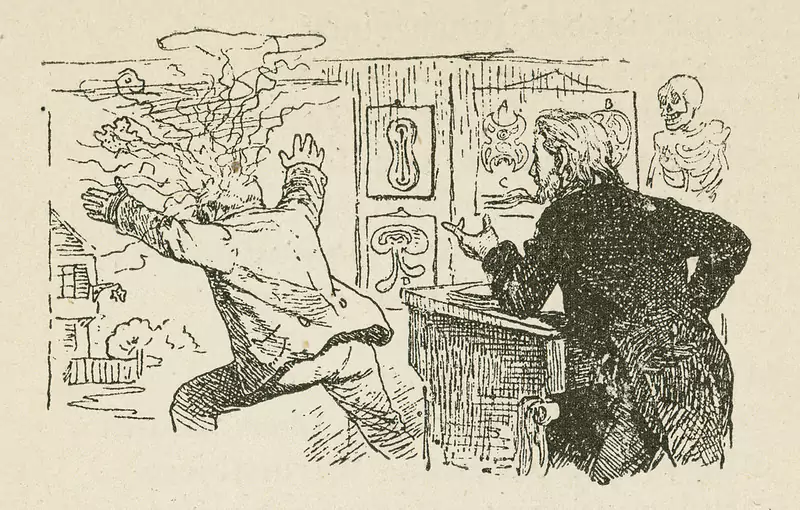 Fünf Bücher Haeckel (1882)—a spoof of Haeckel’s Anthropogenie—a bewildered listener, his mind blown, flees from a lecture to an inn. ” width=”800″ height=”510″ class=”size-full wp-image-19604″ /> Some readers found embryology too difficult. In this illustration by Fritz Steub from Moritz Reymond’s Fünf Bücher Haeckel (1882)—a spoof of Haeckel’s Anthropogenie—a bewildered listener, his mind blown, flees from a lecture to an inn.
Fünf Bücher Haeckel (1882)—a spoof of Haeckel’s Anthropogenie—a bewildered listener, his mind blown, flees from a lecture to an inn. ” width=”800″ height=”510″ class=”size-full wp-image-19604″ /> Some readers found embryology too difficult. In this illustration by Fritz Steub from Moritz Reymond’s Fünf Bücher Haeckel (1882)—a spoof of Haeckel’s Anthropogenie—a bewildered listener, his mind blown, flees from a lecture to an inn.Copying was at issue from the beginning: Haeckel’s first accuser said his plates manufactured false identities by miscopying standard illustrations from the literature. Haeckel insisted privately that his own specimens had informed his drawings too, and stressed he had allowed himself—as was not standard then—to depict all the embryos in the same view, at the same size, and in the same dramatic style. Those googly eyes perhaps owed more to the tricks of the popular lecturer than university professors usually committed to print. More positively, and less remarked, the arrangement of the figures created the innovative grid design. The plate in the first edition of the Schöpfungsgeschichte offered three pairwise comparisons, of dog and human embryos at an early stage, and of dog and human, turtle and chick, at a later one. “During the first two months of development,” Haeckel thundered, even “nobles … are scarcely distinguishable from the tailed embryos of the dog and other mammals.” But the pairs did not yet make a grid.
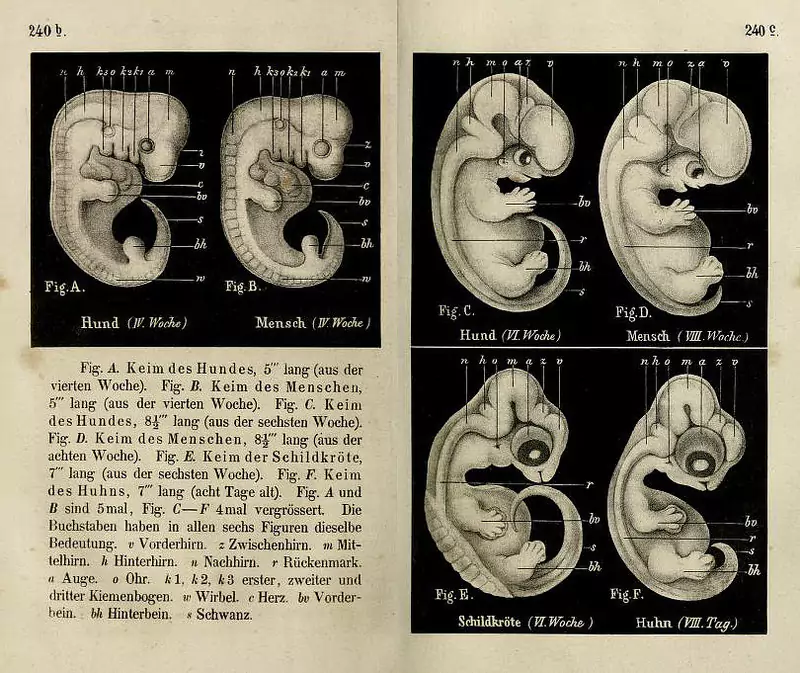 Natürliche Schöpfungsgeschichte.” width=”800″ height=”673″ class=”size-full wp-image-19605″ /> The embryo double plate in the first (1868) edition of Haeckel’s Natürliche Schöpfungsgeschichte.
Natürliche Schöpfungsgeschichte.” width=”800″ height=”673″ class=”size-full wp-image-19605″ /> The embryo double plate in the first (1868) edition of Haeckel’s Natürliche Schöpfungsgeschichte.Only in the second edition, when all captions moved to the back of the book, did Haeckel and the lithographer take advantage to set up a grid that powerfully aligned the embryos for easy comparison at each stage. It was challenging enough to construct a developmental series for one species: material was scarce—the earliest human embryos were unknown until the mid-twentieth century—and it took much cutting, drawing, and interpreting to turn the nondescript contents of eggs or clumps in blood into clear and comparable images. To coordinate such series for multiple species was harder still, but the grid created an inviting space.
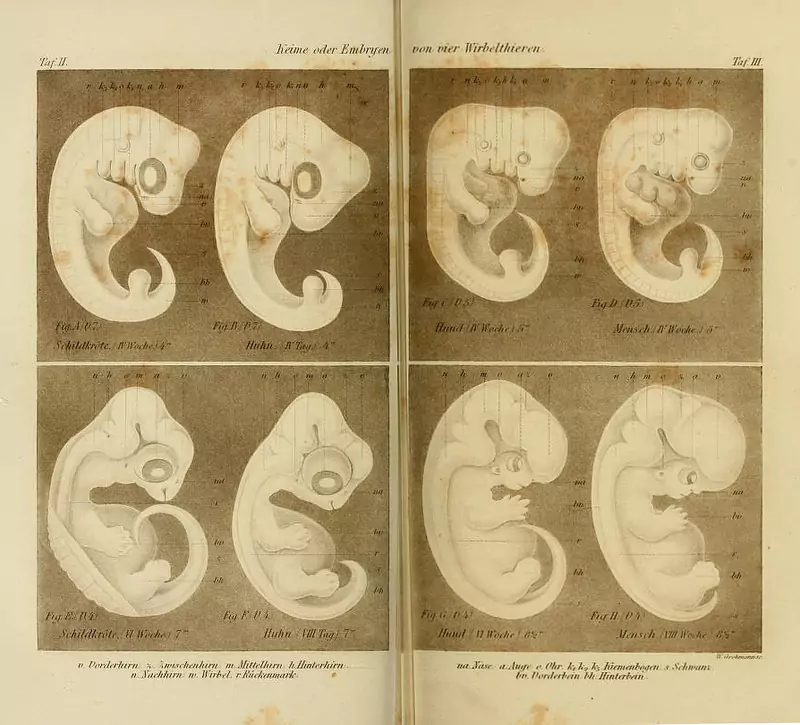 Schöpfungsgeschichte.” width=”800″ height=”725″ class=”size-full wp-image-19606″ />
Schöpfungsgeschichte.” width=”800″ height=”725″ class=”size-full wp-image-19606″ /> The embryo plates in the fourth (1873) edition of Haeckel’s Schöpfungsgeschichte.
Later editions of Haeckel’s books revised and expanded the plates. The early ones had drawn on the German farmyard, heath, and forest, but as embryologists exploited networks of empire, Haeckel added such exotics as ostrich, spiny anteater, koala, and gibbon. The grid structure encouraged him to fill with “deductions” some cells that a more prudent zoologist might have left empty pending further research. That would damage his reputation when these late editions, which themselves accounted for a small fraction of the copies in circulation, were the basis for plates in cheap pamphlets that kindled controversy on the eve of World War I. Most translations amplified the early grids, but Haeckel’s extraordinary fame around 1900 justified a second English version of the Anthropogenie and this carried the full imperial parade.
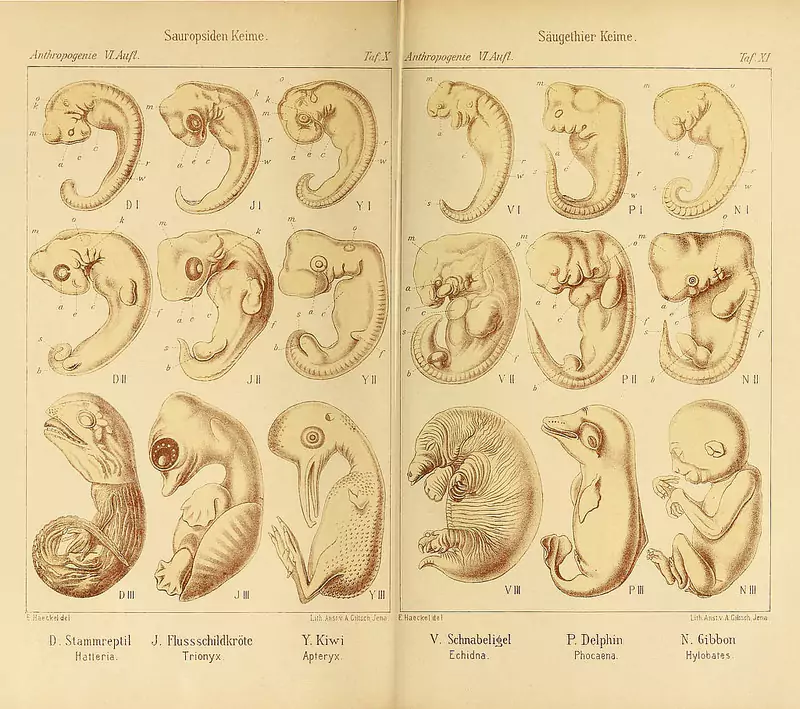 Anthropogenie. The species are tuatara, river turtle, kiwi, spiny anteater, dolphin, and gibbon.” width=”800″ height=”709″ class=”size-full wp-image-19607″ />
Anthropogenie. The species are tuatara, river turtle, kiwi, spiny anteater, dolphin, and gibbon.” width=”800″ height=”709″ class=”size-full wp-image-19607″ /> Two of six comparative embryological plates in the fifth (1903) and sixth (1910) editions of Haeckel’s Anthropogenie. The species are tuatara, river turtle, kiwi, spiny anteater, dolphin, and gibbon.
 The Evolution of Man (1905). Exemplifying the perils of translating labels, spiny anteater (echidna) has been rendered as sea-urchin (Echinus).” width=”741″ height=”633″ class=”size-full wp-image-19608″ />
The Evolution of Man (1905). Exemplifying the perils of translating labels, spiny anteater (echidna) has been rendered as sea-urchin (Echinus).” width=”741″ height=”633″ class=”size-full wp-image-19608″ /> The same plates in The Evolution of Man (1905). Exemplifying the perils of translating labels, spiny anteater (echidna) has been rendered as sea-urchin (Echinus).
Yet an image does not become iconic through publication in books by a Haeckel or even a Darwin alone; it needs to be copied further. Haeckel’s embryos were reproduced in other evolutionary works as evidence of common descent. Authors and illustrators either did not know about the forgery charges or discounted them. But there are significant absences: no German professor used Haeckel’s drawings for decades and some of his staunchest defenders played safe by assembling their own embryo groups instead. In the 1890s, his embryos, first published in books printed a thousand or two at a time, nevertheless entered encyclopedias with runs of a quarter million per edition.
 Meyers Konversationslexikon (1894). ” width=”900″ height=”1024″ class=”size-full wp-image-19609″ />
Meyers Konversationslexikon (1894). ” width=”900″ height=”1024″ class=”size-full wp-image-19609″ /> Haeckel’s turtle, chick, and rabbit embryos in the encyclopedia Meyers Konversationslexikon (1894).
Copying not only makes images known, it may also simplify or modify them as users select a canonical form. Today, “Haeckel’s embryos” are almost synonymous with reproductions and adaptations of the double plate in the first edition of the Anthropogenie, but it took many years for this one to win out. Two-limit scenarios represent the range of early copies from both Schöpfungsgeschichte and Anthropogenie. At one extreme, authors treated the grids in academic lectures by a distinguished German professor as authoritative sources of figures, and raided them for individual drawings. This made simpler illustrations, more suited to more popular books, and cheaper, especially when they had to be re-lithographed or re-engraved. The most unusual is an art nouveau chapter header from Das Liebesleben in der Natur (Love life in nature), the bestselling eroticization of evolutionism by Haeckel’s ally and friend Wilhelm Bölsche.
 Schöpfungsgeschichte appear on the same lithograph as authoritative drawings by leading embryologists in Henry Chapman’s Evolution of Life (1873).” width=”644″ height=”391″ class=”size-full wp-image-19610″ /> The earliest known copies of embryos from Haeckel’s Schöpfungsgeschichte appear on the same lithograph as authoritative drawings by leading embryologists in Henry Chapman’s Evolution of Life (1873).
Schöpfungsgeschichte appear on the same lithograph as authoritative drawings by leading embryologists in Henry Chapman’s Evolution of Life (1873).” width=”644″ height=”391″ class=”size-full wp-image-19610″ /> The earliest known copies of embryos from Haeckel’s Schöpfungsgeschichte appear on the same lithograph as authoritative drawings by leading embryologists in Henry Chapman’s Evolution of Life (1873).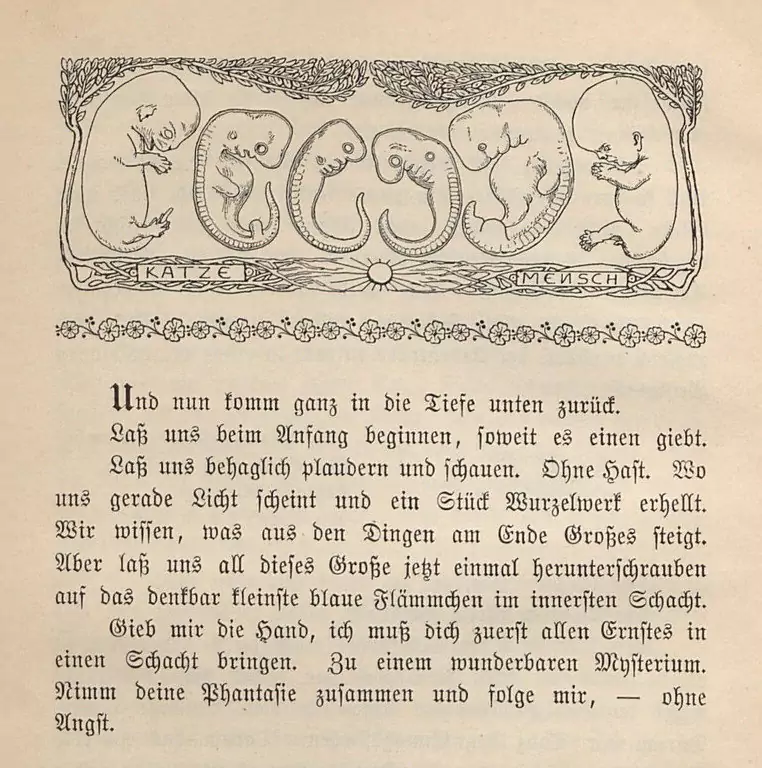 Das Liebesleben in der Natur (1898). ” width=”762″ height=”768″ class=”size-full wp-image-19611″ /> Header by Wilhelm Müller-Schönfeld after Haeckel’s cat and human embryos in Wilhelm Bölsche’s Das Liebesleben in der Natur (1898).
Das Liebesleben in der Natur (1898). ” width=”762″ height=”768″ class=”size-full wp-image-19611″ /> Header by Wilhelm Müller-Schönfeld after Haeckel’s cat and human embryos in Wilhelm Bölsche’s Das Liebesleben in der Natur (1898).At the other extreme, expert evolutionists implicitly accepted the criticism of Haeckel, keeping the grid structure but replacing every figure to provide impeccable evidence for largely Haeckelian conclusions. These accurate arrays were rather unsuccessful, however, and by the early twentieth century, books increasingly borrowed Haeckel’s plates as redrawn and engraved in an uncontroversial secondary source, George John Romanes’s “exposition of Darwinian teaching” in the first volume of Darwin and After Darwin. Via photomechanical printing, it was now straightforward to reproduce the whole grid.
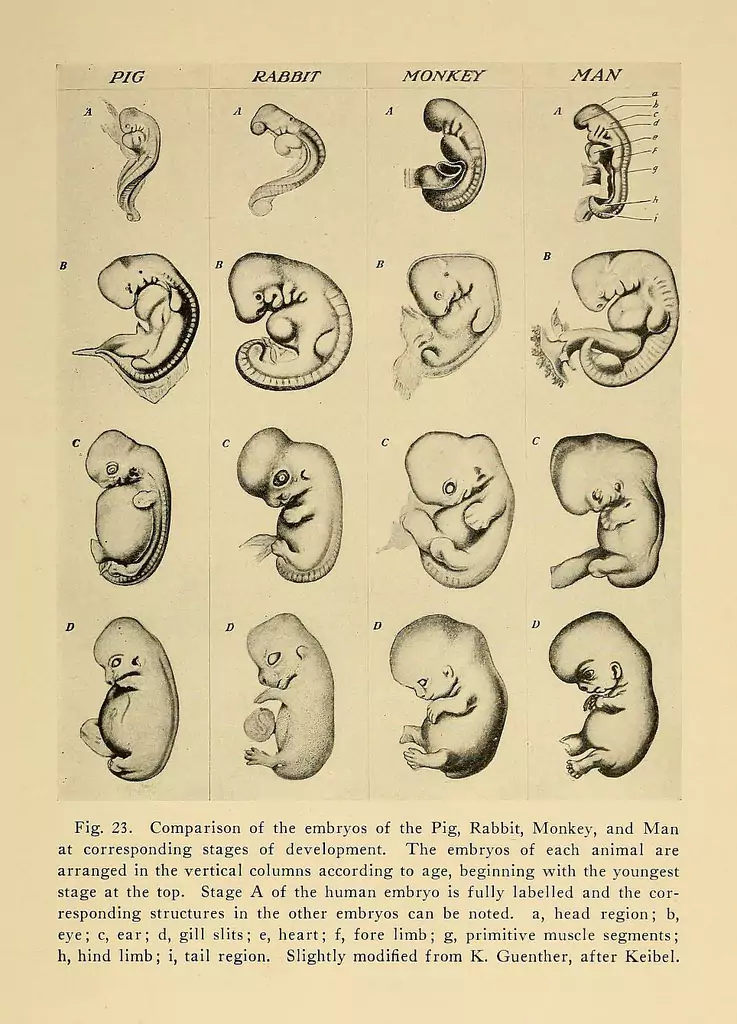
Four columns from an accurate German grid in a series of lectures on evolution given at Yale in 1921–2.
 Darwin and After Darwin, vol. 1 (1892).” width=”870″ height=”695″ class=”size-full wp-image-19613″ /> The most influential copies of Haeckel’s embryos, in Romanes’s Darwin and After Darwin, vol. 1 (1892).
Darwin and After Darwin, vol. 1 (1892).” width=”870″ height=”695″ class=”size-full wp-image-19613″ /> The most influential copies of Haeckel’s embryos, in Romanes’s Darwin and After Darwin, vol. 1 (1892).All this time, the forgery charges had been continually rewarmed. As an outcome of the battles over Haeckel in the 1870s, Darwinism was effectively banned from German schools, but this added an extra frisson of transgression to viewing these forbidden fruits. Religion teachers, catching children reading Haeckel under the desk, denounced his pictures as “outrageous forgeries.” Traditionalist parents warned their daughters that such horrible illustrations were unsuitable for girls. The embryos conducted ideological sparks across the generations and between milieux. Then Haeckel became an even bigger target through his role in creating a mass audience for science. The Riddles of the Universe, his (unillustrated) primer of scientistic anticlericalism, sold some 400,000 in German alone and was translated into a dozen languages. The most famous and notorious German scientist, the greatest living evolutionist, was a lightning rod for controversy and a target for legions of enemies, especially on the Christian right (Haeckel moved rightwards himself, but had more supporters among liberals and on the left, a fact that became awkward when some Nazis celebrated this advocate of eugenics or “racial hygiene”).
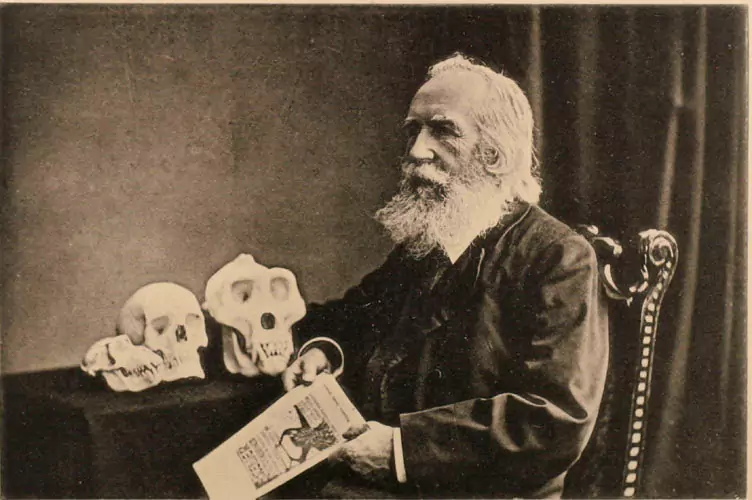
Portrait photograph of Haeckel as human evolutionist (1907).
Fearful of working-class atheism, in 1908, right-wing populists leveled new charges against plates in pamphlets after big public lectures by Haeckel. Newspapers whipped up a scandal for the people. Biologists rallied around the figurehead of German Darwinism and against the threat of political interference, without condoning the drawings. But after he died in 1919, his reputation declined further, as physiological approaches made the running in embryology and highbrows looked down on his popular philosophy. American textbooks saved his pictures.

“Germs of three mammals,” a halftone plate in a pamphlet based on a lecture Haeckel gave in 1907.

Front cover of the 1908 polemic in which Arnold Brass (here, unusually, Brasz) detailed his charges against Haeckel.
Textbooks notoriously recycle images as well as errors, but for lack of direct evidence, specific cases can be difficult to explain. Patterns of use help. Haeckel’s diagrams were introduced into the United States much earlier than Germany, because high schools taught more evolution-based elementary biology and Americans knew less about the accusations. Even after 1925, when the state of Tennessee outlawed human evolution in the public schools and tried John Scopes for teaching “that man has descended from a lower order of animals,” the embryos stayed in schoolbooks, albeit in bowdlerized form.
 Elementary Biology (1919). ” width=”726″ height=”540″ class=”size-full wp-image-19617″ /> Haeckel’s embryos in Benjamin C. Gruenberg’s successful high school textbook Elementary Biology (1919).
Elementary Biology (1919). ” width=”726″ height=”540″ class=”size-full wp-image-19617″ /> Haeckel’s embryos in Benjamin C. Gruenberg’s successful high school textbook Elementary Biology (1919).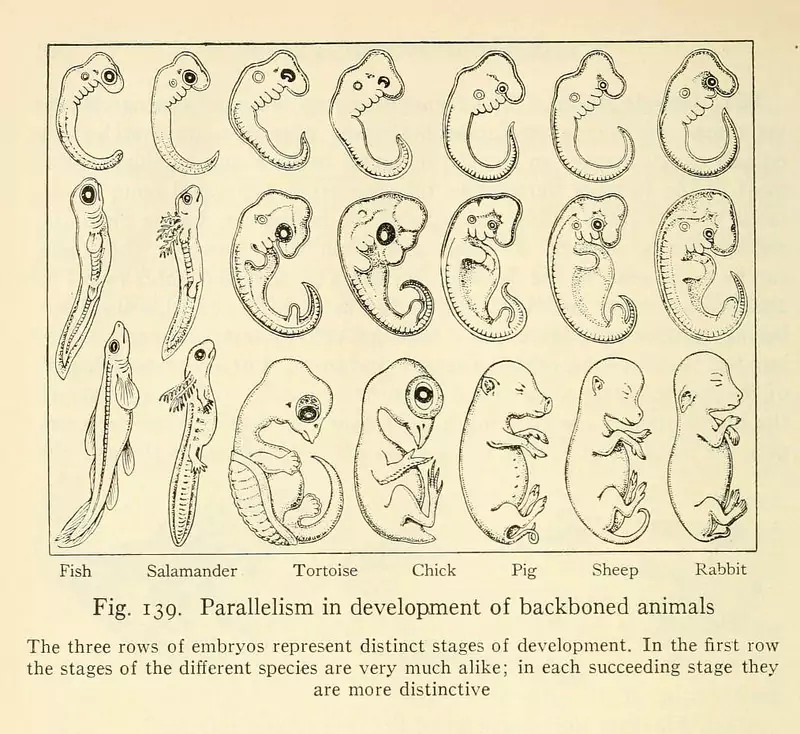 Biology and Human Life (1925) omitted the human embryos in response to the antievolution campaign. ” width=”800″ height=”734″ class=”size-full wp-image-19618″ /> Gruenberg’s Biology and Human Life (1925) omitted the human embryos in response to the antievolution campaign.
Biology and Human Life (1925) omitted the human embryos in response to the antievolution campaign. ” width=”800″ height=”734″ class=”size-full wp-image-19618″ /> Gruenberg’s Biology and Human Life (1925) omitted the human embryos in response to the antievolution campaign.College textbooks reproduced the drawings from around 1930 because they “excel in emphasizing essential agreements and ultimate differences.” Expansion of the books and the bureaucratization of the industry established the general conditions for recycling. Specific factors explain how these images survived big threats: the modern evolutionary synthesis (which at mid-century ousted Haeckel’s, by implication, unmodern one) and the curriculum modernization of the 1960s. Creationists, the most dogged critics, were marginal, and few evolutionists realized what a question mark hung over the pictures. Their use was favored by the confused legacy of comparative evolutionary embryology (was recapitulation simply wrong, or was there a core of truth? Did embryos recapitulate adult forms, or only embryonic ones?). Use was stereotyped. Take a mid-century college textbook, turn to the chapter on “Evidences of organic evolution,” find no. 3: “Comparative embryology,” and chances are the most readily available image will illustrate a few formulaic paragraphs in a stable combination or “imagetext.” The pictures were also protected by crediting Romanes, not Haeckel. The text might say that Haeckel was wrong, or at best overzealous; that recapitulation was false, or at least an exaggeration; and that the embryos did not march in parallel, but rather diverged—and point to his drawings to prove it. This could happen because the images were never a readout of the recapitulation theory, but primarily display similarity and divergence, and so were open to alternative evolutionist interpretations.

Haeckel’s embryos as a question on the cover of a magazine that promoted evolution teaching after the Scopes trial. The answer was number 9.
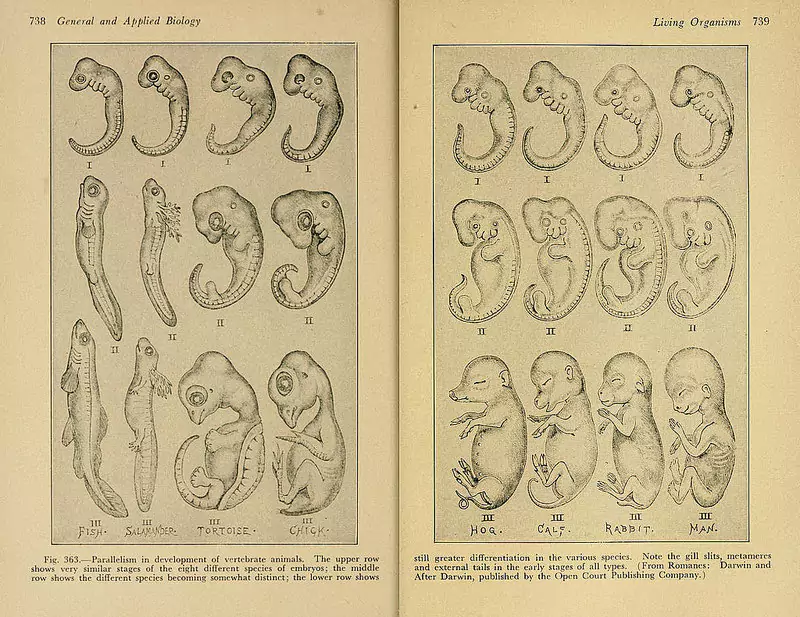 The Science of Biology, 4th edition (1952).” width=”800″ height=”617″ class=”size-full wp-image-19620″ /> Embryos after Romanes as “Evidences from comparative embryology” in a section on “Descent with change” in William C. Beaver’s The Science of Biology, 4th edition (1952).
The Science of Biology, 4th edition (1952).” width=”800″ height=”617″ class=”size-full wp-image-19620″ /> Embryos after Romanes as “Evidences from comparative embryology” in a section on “Descent with change” in William C. Beaver’s The Science of Biology, 4th edition (1952).These embryos had nevertheless been all but absent from one whole class of book: those devoted to embryology. The images were imported from more general works only in the early 1980s, when interest in “evolution and development” revived. They structured knowledge even in advanced reviews that renovated the idea, elaborated from Haeckel’s grids, that there is a stage—his top row—on which vertebrates converge from different beginnings and from which they then diverge. This set the scene for the latest round of forgery charges. In 1997, a London developmental biologist denied there is a sharply defined common stage, and the rise of creationism, fraud-busting, and the internet amplified his claim. The diagrams were expunged from the textbooks, but creationists did not want to remove all trace. In a typical irony of iconoclasm, they ensured that the embryos were more reproduced than ever before—as negative icons of Darwinist infamy.
For a while it looked as though the pictures would be used only where distancing was understood, such as by creationists or historians of science. But at the end of 2010, they occupied the most sought-after space in science publishing, the cover of the leading journal Nature. Illustrating articles that used genomic methods to confirm the conserved stage, Haeckel’s grid took the form of a mosaic generated by sampling a database of gene expression patterns in fruit-fly embryos. The drawings had not just hung on; they were still involved in innovation after 140 years. Who would bet that they will not one day be more fully rehabilitated, and if they are, that they do not start a major controversy again?
There is another irony. Haeckel’s embryos could spread because they were effectively in the public domain. German copyright law allowed reproduction with acknowledgement; permission to reproduce from Romanes was readily granted; and publishers redrew the figures. But in the early 2000s, when critics and defenders of evolution contested the history on blogs, it became clear that specific copies from Haeckel and Romanes could be hard to find. One library rarely held all editions and few of the relevant textbooks were online.
Many of Haeckel’s embryos are freely available all the same. Their histories show how copying produced an image family and how the differences mattered. From the making of the first grid through the variations that adapted it to a host of other books, copying has been creative. In the accusation that Haeckel miscopied standard images, it has been contested. And, from the battles of the 1870s to the recent dispute over the conserved stage, it has been consequential. That is the shock of the copy.
Follow us on Reddit for more insights and updates.



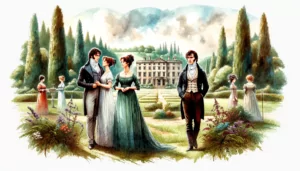

Comments (0)
Welcome to A*Help comments!
We’re all about debate and discussion at A*Help.
We value the diverse opinions of users, so you may find points of view that you don’t agree with. And that’s cool. However, there are certain things we’re not OK with: attempts to manipulate our data in any way, for example, or the posting of discriminative, offensive, hateful, or disparaging material.